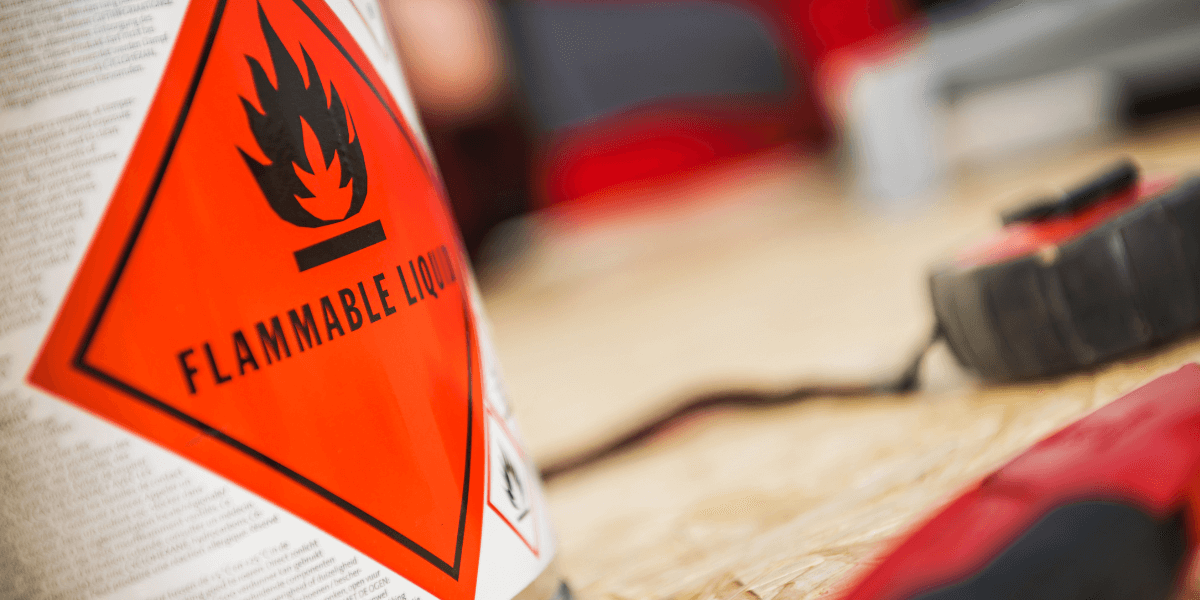What Class of Fire is Flammable Liquids?

Ask someone what class of fire is flammable liquids and you'll probably get a mix of guesses. Most folks don't think about fire types until they're staring down a real emergency—or shopping for an extinguisher and realizing the label looks more like a quiz than a safety tool.
However, fire classification is how firefighters, business owners, and everyday people keep things under control when something goes wrong. Fires behave differently depending on what's burning, and the way you stop one kind can be useless—or dangerous—against another.
Class B fires are one of the most misunderstood types. These involve flammable liquids like gasoline, oil, solvents, and alcohol. They spread fast, can't be doused with water, and require specific tools to extinguish safely. Knowing how they work and what sets them apart can make all the difference in high-risk situations—at home, at work, or on the road.
Let's break down class C fires in a way that's clear and a little less intimidating, and let's also talk about the right fire protection for these.
Key Takeaways
- Class B fires involve flammable liquids and spread quickly if not handled correctly.
- Using the wrong extinguisher on a Class B fire can worsen the situation and pose serious risks.
- Preventive storage, proper labeling, and professional maintenance are essential for fire safety.
Defining Class B Fires
Class B fires involve flammable or combustible liquids—gasoline, oil, alcohol, solvents, and even certain cleaning agents. These fires don't start with wood or paper like Class A fires. They ignite when a liquid or gas catches fire, usually from a spark or heat source, and they spread rapidly across surfaces.
The thing that separates a Class B fire from others is the fuel source. It's not about what's burning—like a wall or an appliance—but what it is burning in. Flammable liquids can vaporize easily and mix with air, which makes them highly reactive. A small spill in an industrial setting or even a garage can become dangerous fast.
These aren't fires you put out with water. In fact, that's the wrong type of reaction entirely because water can spread the flames and make things worse.
Knowing which class you're dealing with matters. Mixing up a Class B fire with something like Class C (electrical fires) or Class D (combustible metals) can lead to using the wrong extinguisher and causing more harm than good. We'll get into those differences next—but for now, remember: if it's a flammable liquid, it's a Class B.
Distinguishing Class B from Other Fire Classes

Not all fires burn the same—and not all fires should be treated the same way, which is why the fire classification system exists: to sort fires based on what's fueling them. Knowing the difference can mean a faster, safer response.
- Class A fires involve ordinary combustible materials—paper, wood, cloth, and trash. These are your typical "campfire" types of fires. They burn solid, organic materials and are generally the most straightforward to extinguish.
- Class C fires are electrical. They start in energized electrical equipment—things like outlets, appliances, or wiring. They require non-conductive extinguishing agents because spraying the wrong thing could mean electrical shock or further damage.
- Class D fires are much more specialized. These involve combustible metals, such as magnesium or titanium, typically found in industrial environments. They require specific extinguishers designed to react safely with burning metal.
- Class K fires, on the other hand, deal with commercial cooking environments, specifically fires from cooking oils and fats. While oils are technically liquids, they behave differently than the flammable liquids in Class B, which is why they get their own category.
Each fire class is defined by its fuel source and it's what puts flammable liquid fires squarely in the Class B category.
Common Causes and Scenarios
Class B fires don't need much to get going—just a flammable liquid, a source of ignition, and the right conditions. And because those ingredients are all around us, these fires can happen in more places than most people realize.
It can happen in homes and businesses
In homes, it might be something as simple as spilled gasoline near a water heater or a can of paint thinner left uncapped in a warm garage. Grease used for car maintenance, cleaning solvents, and fuel for lawn equipment can all ignite under the wrong circumstances.
In commercial and industrial settings, the risk increases with volume and activity.
Warehouses that store large quantities of flammable liquids, auto repair shops handling fuel and oil, and manufacturing spaces using chemical solvents are all potential flashpoints. Even static electricity or a spark from equipment can be enough to trigger a fire if the vapors are concentrated.
One of the biggest issues is vapor. It's not always the liquid itself that catches—it's the invisible fumes that spread across the floor and reach an ignition source before you even realize what's happening. That's what makes these fires so fast and, at times, hard to predict.
The key takeaway: just because it's stored in a bottle or barrel doesn't mean it's safe. Knowing where flammable liquids are used or stored—and how they behave—is the first step toward preventing a fire that spreads before you can reach an extinguisher.
Fire Suppression Techniques for Class B Fires
Class B fires involve flammable liquids, so using water is ineffective and can instead spread the flames by pushing the burning liquid around.
The right tools are Class B fire extinguishers, which are designed to smother the fire rather than fuel it. These typically use foam, dry chemical agents, or carbon dioxide (CO₂). Each one works a bit differently, but the goal is the same: cut off the fire's access to oxygen or interrupt the chemical reaction that keeps it going.
Extinguishers to use
Dry chemical extinguishers are some of the most common and versatile. They're fast-acting, coat the fuel source, and prevent reignition.
CO₂ extinguishers work well in enclosed spaces where residue would be a problem, like near electronics, since they leave nothing behind. Foam extinguishers are especially effective on pooled liquids, covering the surface to prevent vapors from escaping.
Numerical rating
Extinguishers have numerical ratings that indicate how much fire they can handle, usually in square feet. A higher number means more coverage. But regardless of size, make sure the extinguisher specifically lists Class B on the label. If you use the wrong type—say, one made for Class A or Class C fires—you risk making the situation worse.
Quick response matters, but so does using the right method. Class B fires move fast, and hesitation or the wrong tool can turn a small flare-up into a full-blown emergency.
Preventative Measures
Most Class B fires can be avoided with a few smart habits and some basic planning. Flammable liquids aren't dangerous by default—it's how and where they're stored that makes the difference.
Safe storage
Start with the container. Use only approved, properly labeled containers designed for flammable or combustible liquids. Keep them tightly sealed when not in use and store them away from ignition sources like heaters, open flames, or running electrical equipment.
Ventilation
Ventilation matters, too. Fumes can linger and travel, especially in enclosed or poorly ventilated spaces. A small spark near an invisible vapor trail is all it takes. Keeping storage areas cool, dry, and well-aired can significantly reduce risk.
Signage and training
In workplaces, proper signage, spill kits, and regular training go a long way. Even in homes, designating a fire-safe cabinet or detached storage area can make a big impact. And always, always keep Class B fire extinguishers nearby and accessible—just in case.
Regulatory Standards and Compliance
Both OSHA and the NFPA have clear guidelines on how flammable liquids should be stored, labeled, and handled—especially in commercial and industrial settings. These rules aren't just for large facilities. They apply to small businesses, workshops, and even garages that keep fuel or solvents on-site.
Hazard classes define how volatile a liquid is based on its flash point and boiling point. Labels and safety data sheets (SDS) must be visible, up-to-date, and show exactly what's inside each container and how to respond in an emergency.
There are also limits on how much of a flammable liquid can be stored in a given area, how containers must be grounded, and what type of extinguishing equipment must be on hand. These standards exist for a reason: they're built from real-world incidents, and they're designed to keep people safe.
If it seems like a lot to track, that's because it is—which is why many businesses turn to fire safety professionals to help them stay compliant and ready.
The Role of Professional Fire Safety Services
Having the right fire extinguisher is one thing—knowing it's still charged, properly placed, and ready when you need it is something else entirely. This is where you need professional fire safety services.
Businesses that work with flammable liquids or electrical equipment have specific responsibilities when it comes to fire safety. From knowing which extinguishers to install to ensuring compliance with inspection schedules, the details can get overwhelming fast. It's the reason why many companies rely on certified experts to keep them covered.
Conclusion
Class B fires may start with a spill or a spark, but without the right response, they can escalate fast. Knowing what they are—and how to deal with them—makes all the difference. Whether at home or on the job, a few smart precautions can go a long way in keeping people, property, and businesses safe.
Stay Ready, Not Reactive
Swartz Fire & Safety helps businesses across industries stay prepared. That might mean inspecting and servicing Class B and Class C extinguishers, reviewing site layouts for better coverage, or helping a shop owner identify where grease buildup could pose a fire risk. We also provide training because even the best equipment is only as effective as the person using it.
Our team is familiar with the different types of extinguishers and the environments they're designed for. We know what the regulations require, but we also understand the realities of running a business. Fire safety has to work in the real world, not just on paper.
When everything's in place—equipment, training, maintenance—you know your fire plan won't fall short when it matters most.
Contact us for your FREE consultation.
Frequently Asked Questions
What class type is flammable liquid?
Flammable liquids fall under Class B fires, which include substances like gasoline, oil, and solvents.
What are class AB and C fires?
Class A involves ordinary combustibles like wood and paper, Class B involves flammable liquids, and Class C involves electrical equipment.
Are flammable liquids a class B fire?
Yes, flammable and combustible liquids are classified as Class B fires.
What is a Class D fire extinguisher used for?
Class D extinguishers are designed for fires involving combustible metals such as magnesium or titanium.


